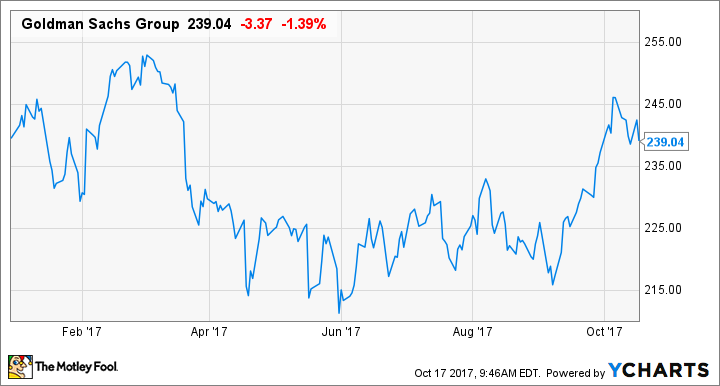Goldman Sachs Earnings: A Strong Quarter After a Weak Start to 2017
Investment banking giant Goldman Sachs (NYSE: GS) reported third-quarter earnings that not only beat expectations on both the top and bottom lines but beat estimates in several key areas of its business. Here's a quick rundown of the numbers and why Goldman's investors should be especially encouraged by the third quarter's strong performance.
Strong numbers in most areas of the business
First, the headline numbers. Goldman Sachs generated $8.33 billion in revenue during the third quarter, handily beating analyst expectations of $7.54 billion. On the bottom line, the results were even more impressive. Due to the higher revenue and the company's effective cost controls, which kept expenses virtually unchanged despite the revenue growth, Goldman's earnings of $5.02 per share beat estimates by more than 20%.

Investment banking revenue was a particularly strong point in the results, coming in well ahead of estimates and 17% higher than a year ago. The bank's return on equity (ROE) of 10.9% exceeds the 10% industry benchmark.
Through the first three quarters of 2017, Goldman had the leading market share in announced and completed mergers and acquisitions, as well as in common stock offerings. Assets under supervision grew to $1.46 trillion, fueled by strong market performance as well as net inflows.
Finally, Goldman was actively repurchasing its stock during the quarter, spending $2.17 billion to buy back 9.6 million shares -- an average cost of $225.12 per share. This is about 7% less than the current share price, so it appears that Goldman successfully capitalized on the weakness in its share price during much of the quarter.
Trading revenue remains weak, but...
One area of weakness across the entire banking industry is trading, specifically bond trading. Without getting too deep into the reasons, the low-volatility market environment simply isn't conducive to high trading volumes.
Goldman's fixed income trading revenue for the quarter was $1.45 billion, a 26% year-over-year drop, which was steeper than the declines reported by peers Citigroup and Bank of America but slightly better than JPMorgan Chase's 27% slump. However, analysts had been expecting just $1.38 billion, so Goldman handily beat the market's expectations.
Equities trading revenue fell 7% year over year, and overall, Goldman's trading revenue was 17% lower than the third quarter of 2016. However, it increased 2% from last quarter, which could be taken as a positive sign.
Why Goldman's strong third quarter is so important
Goldman's performance thus far in 2017 has been mixed, and a less-than-stellar earnings report earlier this year left many investors nervous. Specifically, Goldman Sachs missed earnings and revenue expectations for the first quarter, a rarity for the bank and its first earnings miss since 2015. Investors were left wondering if the miss was an isolated one or a sign of things to come.
Well, it appears investors have their answer. With a solid earnings beat and impressive results throughout its business, Goldman Sachs showed investors that it's still one of the best in the business and that its higher share price is well deserved.
More From The Motley Fool
Why You're Smart to Buy Shopify Inc. (US) -- Despite Citron's Report
6 Years Later, 6 Charts That Show How Far Apple, Inc. Has Come Since Steve Jobs' Passing
NVIDIA Scores 2 Drone Wins -- Including the AI for an E-Commerce Giant's Delivery Drones
Matthew Frankel owns shares of Bank of America. The Motley Fool has no position in any of the stocks mentioned. The Motley Fool has a disclosure policy.

 Yahoo Finance
Yahoo Finance 
